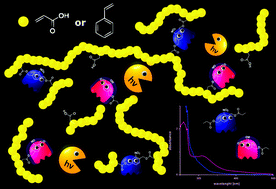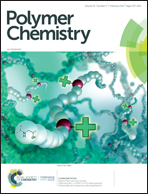Synthesis and degradation of branched, photo-labile poly(acrylic acid) and polystyrene†
Abstract
We present the synthesis, characterization and photolytical degradation of branched photo-responsive poly(acrylic acid) and polystyrene using free radical polymerization of acrylic acid/styrene in the presence of a newly synthesized asymmetric o-nitrobenzyl-based crosslinker and different amounts of dodecanethiol (DDT) as a chain transfer agent. Thereby, an asymmetric o-nitrobenzyl-based crosslinker ((2-nitro-1,4-phenylene)bis(methylene) diacrylate) was used, as the expected degradation products can be easily analyzed. Both the crosslinker and the resulting branched polymers were decomposed by irradiation with UV-light (100 W mercury lamp, 15 mW cm−2) and their degradation products were analyzed by UV-Vis and NMR spectroscopy, size-exclusion chromatography (SEC), and electron spray ionization mass spectrometry (ESI-MS). After 90 min of irradiation, nearly 80% of the crosslinker was degraded, resulting in nearly linear polymeric decomposition products of comparable molecular weight, independent of the used comonomer. Thus, only the amount of incorporated crosslinker seems to have an influence on the decomposition products. All these results serve to better understand the structure and architecture of long-chain branched polymeric materials.



 Please wait while we load your content...
Please wait while we load your content...